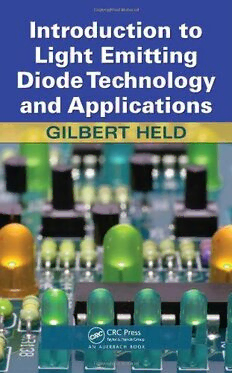Download Introduction to Light Emitting Diode Technology and Applications PDF Free - Full Version
Download Introduction to Light Emitting Diode Technology and Applications by Gilbert Held in PDF format completely FREE. No registration required, no payment needed. Get instant access to this valuable resource on PDFdrive.to!
About Introduction to Light Emitting Diode Technology and Applications
Recent improvements in LED technology have made them as ubiquitous as cell phones. In fact, LEDs light up almost all cell phones screens. The technology’s myriad applications and low energy use have made it nearly impossible to get through daily chores without coming in contact with LEDs. Probable advances include increased ability of the technology to support more efficient lighting and enhanced communications. With balanced coverage of the basics and future developments, Introduction to Light Emitting Diode Technology and Applications takes you on a tour of the LED evolution. The book begins with a brief history of the effort to enable the device that generates light through modern organic LEDs and reviews the fundamentals and principles of light prior to a detailed explanation of how LEDs generate different colors. After forming this basic foundation, the book examines the key LEDs in lighting and communications. It then discusses the latest opportunities and advancements in high brightness (HB) LED technology, solid state lighting, and handheld electronic applications. As we approach a new decade the role of LEDs is literally set to explode, with organic light emitting diodes emerging as a leading next generation technology for electronic displays and lighting. Challenges still exist, including light extraction, luminosity, and white light generation, not to mention non-technical obstacles such as IP disputes and the lack of standards. This book provides a foundation for resolving these issues and developing new applications for LEDs in the promising general illumination market.
Detailed Information
| Author: | Gilbert Held |
|---|---|
| Publication Year: | 2008 |
| ISBN: | 9781420076639 |
| Pages: | 188 |
| Language: | English |
| File Size: | 2.693 |
| Format: | |
| Price: | FREE |
Safe & Secure Download - No registration required
Why Choose PDFdrive for Your Free Introduction to Light Emitting Diode Technology and Applications Download?
- 100% Free: No hidden fees or subscriptions required for one book every day.
- No Registration: Immediate access is available without creating accounts for one book every day.
- Safe and Secure: Clean downloads without malware or viruses
- Multiple Formats: PDF, MOBI, Mpub,... optimized for all devices
- Educational Resource: Supporting knowledge sharing and learning
Frequently Asked Questions
Is it really free to download Introduction to Light Emitting Diode Technology and Applications PDF?
Yes, on https://PDFdrive.to you can download Introduction to Light Emitting Diode Technology and Applications by Gilbert Held completely free. We don't require any payment, subscription, or registration to access this PDF file. For 3 books every day.
How can I read Introduction to Light Emitting Diode Technology and Applications on my mobile device?
After downloading Introduction to Light Emitting Diode Technology and Applications PDF, you can open it with any PDF reader app on your phone or tablet. We recommend using Adobe Acrobat Reader, Apple Books, or Google Play Books for the best reading experience.
Is this the full version of Introduction to Light Emitting Diode Technology and Applications?
Yes, this is the complete PDF version of Introduction to Light Emitting Diode Technology and Applications by Gilbert Held. You will be able to read the entire content as in the printed version without missing any pages.
Is it legal to download Introduction to Light Emitting Diode Technology and Applications PDF for free?
https://PDFdrive.to provides links to free educational resources available online. We do not store any files on our servers. Please be aware of copyright laws in your country before downloading.
The materials shared are intended for research, educational, and personal use in accordance with fair use principles.

